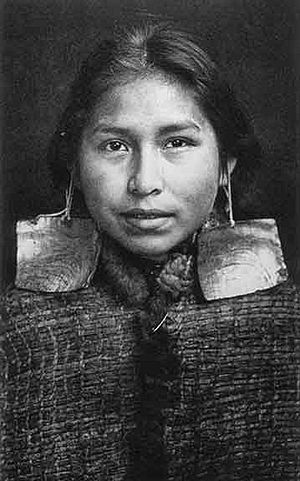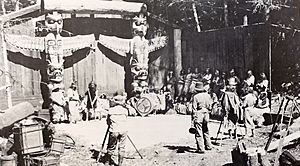In the Land of the Head Hunters facts for kids
Quick facts for kids In the Land of the Head Hunters |
|
|---|---|

Kwagu'ł girl, Margaret Frank (née Wilson) was featured in Curtis's In the Land of the Head Hunters. Here she is shown in a portrait by Curtis wearing abalone shell earrings. Abalone shell earrings were a sign of the noble class.
|
|
| Directed by | Edward S. Curtis |
| Written by | Edward S. Curtis |
| Starring | Maggie Frank |
| Cinematography | Edmund August Schwinke |
| Distributed by | World Film Company |
| Release date(s) | December 7, 1914 |
| Running time | 65 min |
| Country | |
| Language | silent film English intertitles |
In the Land of the Head Hunters (also known as In the Land of the War Canoes) is a 1914 silent film. A silent film means it had no spoken dialogue, only music and written text on screen. This movie tells a fictional story about the Kwakwaka'wakw people. They are an Indigenous group from the Central Coast of British Columbia, Canada.
The film was written and directed by Edward S. Curtis. All the actors in the movie were Kwakwaka'wakw people. This was very special because it was the first full-length movie where all the actors were Native North Americans.
In 1999, the Library of Congress chose this film for the US National Film Registry. This means it was seen as very important for its culture, history, and art. It is also the oldest surviving full-length movie made in Canada.
Contents
How the Film Was First Released
Edward S. Curtis was interested in different ways to tell stories. Before making this movie, in 1911, he created a stage show. It used slides, a lecture, and live music. This show was called The Indian Picture Opera. It helped him get ready for making movies.
The film In the Land of the Head Hunters first opened in New York City and Seattle in December 1914. It had live music played along with it. Curtis hoped the movie would make enough money to finish his big project. This project was The North American Indian, a huge book series about Indigenous tribes.
Even though critics liked the movie, it did not make much money. Curtis spent about $75,000 to make it, but it only earned about $3,200. Because of this, he was very disappointed. He sold all the rights to the film to the American Museum of Natural History around 1919 or 1920. Later, the museum lost the film, and it was thought to be gone forever until 1947.
Finding and Restoring the Film
For many years, the film was lost. Then, in 1947, a film collector named Hugo Zeiter found a damaged copy. He found it in a dumpster and gave it to Chicago's Field Museum of Natural History.
Later, in 1965, two people named Bill Holm and George Quimby got a copy of the film. They worked to put it back together and released a new version in 1974. They added music by Kwakwaka'wakw musicians. This new version was called In the Land of the War Canoes.
In 2008, a big effort was made to restore the film completely. They found other damaged parts of the film and the original music score. This restoration brought all these pieces together.
Is it a True Story or a Drama?
People often wonder if In the Land of the Head Hunters is a true story or a made-up one. It mixes many real parts of Kwakwaka'wakw culture with a dramatic plot. Some parts of the story were based on old traditions, while others were completely made up. Curtis never clearly said if the film was a documentary (a true story) or fiction (a made-up story).
Some parts of the film are very accurate. These include the artwork, ceremonial dances, clothing, and the design of buildings. The way dugout and war canoes were built also showed real Kwakwaka'wakw culture. The film also correctly shows Kwakwaka'wakw rituals like the potlatch. At the time, the Canadian government had banned these rituals, but the film showed them.
However, some parts of the film were not accurate for the time it was made. For example, the parts about headhunting and sorcery were based on very old practices that were no longer common. Some activities, like whaling, were borrowed from other groups and were not part of Kwakwaka'wakw culture. These were likely added to make the movie more exciting.
Story of the Film
The movie tells the story of Motana, who is the son of a great chief. To gain power from the spirit forces, Motana goes on a special journey. During this journey, he is not supposed to think about women. But he keeps dreaming of Naida.
To please the spirits, Motana must pass harder tests. He sleeps on the Island of the Dead. Then, he hunts and kills a whale. He also raids places where sea-lions live.
Motana wants to marry Naida, and their courtship is grand. But Naida, with her dowry (a gift from her family), is also wanted by the Sorcerer. The Sorcerer is old and evil. Naida's father, Waket, is afraid of the Sorcerer's magic. He also fears the Sorcerer's brother, Yaklus, who is a dangerous head-hunter. So, Waket promises Naida to the Sorcerer. This causes a war between the two groups.
Motana, his father Kenada, and their clan decide to get rid of the head-hunters. They attack the village of the Sorcerer and Yaklus in their large canoes. They bring the Sorcerer's head to show he is dead, as some believed he could not die. But Yaklus escapes.
After Motana and Naida's wedding, there is a big celebration with dancing and feasting. But then, Yaklus attacks and burns Motana's village. Motana is left for dead, and Naida is taken captive. At Yaklus's village, there is wild celebrating. Naida's dancing saves her life.
Naida's slave boy, who is also a captive, escapes. He tells Motana what happened. Motana then rescues Naida secretly. The angry Yaklus chases them. Motana bravely goes through the dangerous waters of Hyal Gorge in his canoe. His canoe makes it through, but Yaklus is caught by the water and drowns.
Cast
- Maggie Frank
- Alfred Charlie
- Awidi
- Bob Wilson
- Francine Hunt
- Kwagwanu
- Balutsa
- Paddy 'Malid
- Mrs. George Walkus
- Sarah Constance Smith Hunt
- Stanley Hunt
See also
- Dances of the Kwakiutl (1951), short documentary



